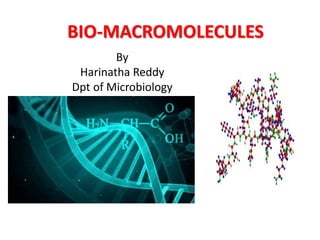
Biomacromolecules and nucleic acids
- 1. BIO-MACROMOLECULES By Harinatha Reddy Dpt of Microbiology
- 2. Biomolecules Bio Macromolecules Bio Micromolecules Proteins Polysaccharides Nucleic acids Amino acids Monosaccharide's (Glucose, Fructose) Nucleotides Lipids Vitamins Molecular weight: 18 to 800 daltons (Da) Molecular weight: >1000 daltons (Da) Or >10000 daltons (Da
- 4. • Biomolecules while those which are found in the acid insoluble fraction are called macromolecules or biomacromolecules.
- 5. There is one feature common to all those compounds found in the acid soluble pool. • They have molecular weights ranging from 18 to around 800 daltons (Da) approximately.
- 6. • The acid insoluble fraction, has only four types of organic compounds i.e., • proteins, • nucleic acids, • polysaccharides • lipids
- 7. • Except lipid the other compounds in acid insoluble fraction consists of have molecular weight range is >10000 daltons.
- 8. • Biomolecules, i.e., chemical compounds found in living organisms are of two types. • Bio micromolecules : less then <1000 daltons.
- 9. Lipids are not polymers • The molecules in the insoluble fraction with the exception of lipids are polymeric substances. • Then why do lipids, whose molecular weights do not exceed 800 Da, come under acid insoluble fraction.
- 10. • Lipids are indeed small molecular weight compounds and arranged into structures like cell membrane and other membranes. • When we grind a tissue, we are disrupting the cell structure. • Cell membrane and other membranes are broken into pieces, and form vesicles which are not water soluble.
- 11. • The membrane fragments in the form of vesicles get separated along with the acid insoluble pool.. • Hence lipids in the Bio macromolecular fraction. • Lipids are not strictly macromolecules..
- 12. • The acid soluble pool represents roughly the cytoplasmic composition. • The macromolecules from cytoplasm and organelles become the acid insoluble fraction. • Together they represent the entire chemical composition of living tissues or organisms.
- 13. • Water is the most abundant chemical in living organisms
- 14. PROTEINS
- 15. Each protein is a polymer of amino acids. • Proteins are polypeptides. • They are linear chains of amino acids linked by peptide bonds.. • a protein is a heteropolymer..
- 16. Essential and Non-essential amino acids • Essential amino acids: Certain amino acids are essential for our health and they have to be supplied through our diet/food. • Dietary proteins are the source of essential amino acids. • Non-essential amino acids : are those which our body can make,,,..
- 17. Proteins carry out many functions in living organisms: • Some transport nutrients across cell membrane, • Some fight infectious organisms, • Some are hormones, • Some are enzymes,..
- 18. • Collagen is the most abundant protein in animal world. • Ribulose bisphosphate Carboxylase-Oxygenase (RuBisCO) is the most abundant protein in the whole of the biosphere
- 20. POLYSACCHARIDES
- 21. Polysaccharides are long chains of sugars • The acid insoluble pellet also has polysaccharides (carbohydrates) as another class of macromolecules.. • They are threads (literally a cotton thread) containing different monosaccharides as building blocks..
- 22. Polysaccharides • Cellulose • Starch • Inulin • Chitin (Complex polysaccharide):
- 23. Starch: • Starch is a present as a store house of energy in plant tissues. • Starch forms helical secondary structures. • Starch can hold I2 molecules in the helical portion. • The starch-I2 is blue in colour
- 24. Starch: Amylose and Amylopectin
- 25. Cellulose • Cellulose consisting of only one type of monosaccharide i.e., Glucose. • Cellulose is a homopolymer.. • Cellulose does not contain complex helices and hence cannot hold I2.
- 26. • Plant cell walls are made of cellulose. • Paper made from plant pulp and cotton fibre is cellulosic.
- 27. Glycogen and Inulin • Animals store glucose in form of glycogen. • Glycogen polymer of glucose.. • Inulin is a polymer of fructose.
- 28. • In a polysaccharide chain (say glycogen), the right end is called the reducing end and the left end is called the non-reducing end.. Reducing end Non Reducing end
- 29. Complex polysaccharides • They have as building blocks, amino-sugars and chemically modified sugars. • Glucosamine • N-acetyl galactosamine.
- 30. Chitin • Exoskeletons of arthropods, for example, have a complex polysaccharide called chitin. • Chitin is a polymer of N-acetyl-Glucosamine.. • These complex polysaccharides are mostly homopolymers..
- 31. NUCLEIC ACIDS
- 33. • Nucleic acids are bio-macromolecule in the acid insoluble fraction.. • Nucleic acids are polynucleotides. • Nucleic acids are building block is a nucleotide
- 34. A nucleotide has three chemically distinct components • One is a heterocyclic compound, • The second is a monosaccharide • The third a phosphoric acid or phosphate
- 35. • The heterocyclic compounds in nucleic acids are the nitrogenous bases: • adenine, guanine, uracil, cytosine, and thymine. • Adenine and Guanine are substituted purines • while the rest are substituted pyrimidines
- 36. • The skeletal heterocyclic ring is called as purine and pyrimidine respectively. • The sugar found in polynucleotides is either ribose (a monosaccharide pentose) or 2’ deoxyribose.
- 37. • A nucleic acid containing deoxyribose is called deoxyribonucleic acid (DNA).. • while that which contains ribose is called ribonucleic acid (RNA).
- 40. THANK YOU
